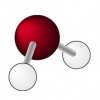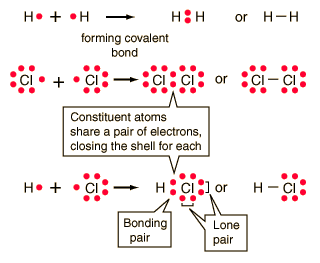A bond is an attraction between atoms. A covalent bond results from the sharing of valence electrons between two atoms. Each covalent bond is made up of one pair of electrons. Both electrons in the bonding pair can be from one atom, or the pair can contain one electron from each atom.
When atoms covalently bond, they share valence electrons so that each atom, with it own electrons and the shared electron give each atom eight valence electrons. (This is true for all atoms except hydrogen, which only needs 2 valence electrons to complete is outer energy level). With the outer energy level filled, the atoms are stable. Meaning they tend not to change.
Atoms that covalently bond form molecules, which are particles made of two or more atoms. Substances, such as table sugar may dissolve in water, but the smallest particle it breaks into is a molecule. Molecules do not form solutions that conduct electricity.
Diatomic molecules
Some elements do not naturally exist as single atoms. Elements that exist as two covalently bonded atoms are called diatomic. The elements that exist as diatomic molecules are hydrogen, nitrogen, oxygen, fluorine, chlorine, iodine, and bromine. These element are gases.
Since the same elements combine to form a diatomic molecule, each atom has the same same amount of attraction for their valence electrons. For two oxygen atoms to combine forming a stable structure, each atom has to have eight valence electrons. In the diagram, there are four (two pairs) shared electrons shown where the two atoms meet. Counting the valence electrons for each oxygen atom, the shared electrons are counted for each atom. Thus each atom has 8 valence electrons.
Hydrogen gas forms the simplest covalent bond in the diatomic hydrogen molecule. Since hydrogen only needs two valence electrons to fill its outer energy level, only one covalent bond is needed. In the diagrams below, Lewis Dot Diagrams are used to show the covalent bonding between the atoms. Since the one covalent bond is made by all the valence electrons in both hydrogen atoms, the optional diagram with a line has no dots. The line represent one covalent bond, which is made of one pair of shared electrons.
Chlorine being in group 17 has seven valence electrons. Two chlorine atoms covalently bone forming a diatomic molecule. Each atom needs one more electron to fill its outer shell with 8 electron. This is accomplished when one covalent bond forms between the two atoms. Note that the shared atoms occupy a space between the two diagrams. Again, a line can be used to indicate the one covalent bond. are shown in the Lewis Dot Diagram

Compounds are made of two or more different kinds of elements. If the atoms of these different elements are covalently bonded, they form molecules. Again, this means that the atoms share a pair of electrons, and that pair is referred to as a bonding pair. The pairs of electrons which do not participate in the bond have traditionally been called “lone pairs”. A single bond can be represented by the two dots of the bonding pair, or by a single line which represents that pair. The single line representation for a bond is commonly used in drawing Lewis structures for molecules.
Molecules made of different kinds of elements (except for carbon), share electrons between the different elements and not between like elements. For example, in a molecule of water, H2O, which contains one oxygen atom and two hydrogen atoms, the covalent bonds are only between oxygen and hydrogen and not between the two hydrogen atoms. As shown in the diagram, hydrogen has energy level with 1 valence electron in it. The first energy level of the atoms of any element has a maximum of two electrons. This means that when hydrogen combines with oxygen it only has 1 electron that it can share with oxygen and it needs oxygen to share one of its electrons. Thus between each hydrogen and oxygen, there is one covalent bond made up of one electron from hydrogen and one electron from oxygen. For more information about Lewis Diagrams and bonding, see HyperPhysics.
hydrogen and one electron from oxygen. For more information about Lewis Diagrams and bonding, see HyperPhysics.
The formula for water is H2O, which indicates that each water molecule has two atoms of hydrogen and one atom of oxygen. Since oxygen has six valence electrons, it need 2 more electrons to complete the stable octet structure. The diagram of water shows oxygen as a red ball and the two hydrogen as smaller white balls. The stick connecting the atoms represents covalent bonds. Each of these covalent bonds is made up of one electron from hydrogen and one electron from oxygen.
